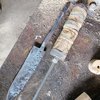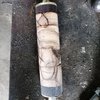nztimb
AH ambassador
Something like these two Gert. Simple to make and you could do one with a the round and one with square . If you have a length of lighter leaf spring and thinned it approprriatly at the bend it will be a spring fuller. The other type of course is the guilitine type fuller where you can change the dies as you need them.













